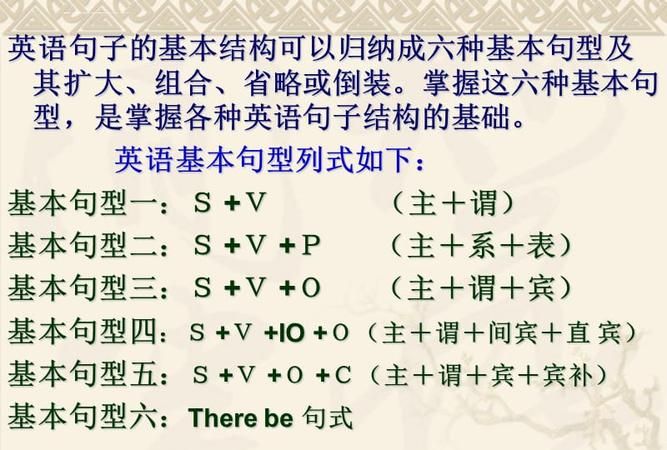本文目录
护士英语口语常用30句
关于英语口语中最常用的30个句型
我们都知道学习英语口语的'关键是语音,然后是句型。有关英语口语句型,方向标英语网之前也介绍了很多。大家还在寻找常见的句型吗?我下面为大家提供英语口语中最常用的30个句型,欢迎大家学习!

1.People have a growing respect for something 人们对......越来越重视
2.Place a high value on something 人们重视、看中、珍爱某物
3.Sharpen ones edge 增强竞争力
4.Give sonebady the edge 是某人具有竞争力
5.Play a central role in 其重要作用
6.Something is beneficial(rewarding) 对.....有好处
7.As ....evolves 随着......的发展
8.Is becoming increasingly rital 变得越来越重要
9.Is becoming increasingly prevalent 变得越来越普遍
10.Generally speaking..........
11.As we all know......
12.Nowadays with the development of .......
13.Peoples views on.......vary from person to person
14.Attitude towards......
15.It is a proverb says.......
16.Have you ever thought that.......
17.These days we often hear about......
but is this really the case A recent studly provided that
18.Some people think that ...however other think that.....
19.Although the popular belief is that...a new survey indicates that..
20.Although it is widely accepted that..it is unlikely to be true that.
21.It is one thing to believe that..it is quite another to say that..
22.There are a variety of cause for this extraordinary growth in....
First.....second.....finally....
23.I fully agree with the stutement that....the reason are chiefly
as follows....
24.Judging from all evidence we may safely draw the concldsion that..
25.Frow what hava been discussed above we may say that......
26.All the evidence supports a condusion that.....
27.It is therefore clear that.....
So we must be aware of the importance of .......
28.Since all of us have realized....why not.......
29.It is high time we put an end to ....
30.It is necessary that effective actions should be taken to prevent
the situation......
;英语口语常见句型合集
英语口语最常见基础句型
英语口语最重要的不是单词量,而是用最简单的英语词汇去把自己的想法表达出来。以下是我整理的英语口语最常见基础句型,希望大家认真阅读!

1. as…as 和……一样
中间必须用形容词或副词原级。例如:
This classroom is as big as that one.
这间教室和那间一样大。
He runs as fast as Tom. 他和汤姆跑的一样快。
否定结构:not as/so…as,“不如……”。上面的两个句子可分别改为:
This classroom is not as/so large as that one.
这间教室不如那间大。
He doesn’t run as/so fast as Tom.
他跑得不如汤姆快。
2. as soon as 一……就……
用来引导时间状语从句。若主句是一般将来时,从句要用一般现在时。例如:
I’ll tell him the plan as soon as I see him.
我一看到他就告诉他这个计划。
He’ll go home as soon as he finishes his work.
他一完成工作就回家。
3. be busy/enjoy/hate/go on/finish doing sth. 忙于/喜欢/讨厌/继续/完成做某事
在enjoy, finish, hate, go on, be busy等词语后,一般用动词-ing形式作宾语。例如:
Lin Tao is busy making a model plane.
林涛正忙着做飞机模型。
My mother enjoys taking a walk after supper.
我妈妈喜欢晚饭后散步。
I hate watching Channel Five.
我讨厌看五频道。
When someone asked him to have a rest, he just went on working.
当有人让他休息一会儿时,他仍继续工作。
I have finished writing the story.
我已经写完了故事。
4. fill…with 用……装满......; be filled with 充满了……;be full of 充满了......
①be filled with 说明由外界事物造成的此种状态,表示被动。例如:
The box is filled with food.
盒子里装满了食物。
②be full of说明主语处于的状态。此外,还可表示程度,意为“非常”。例如:
The patient’s room is full of flowers.
那个病人的房间摆满了花。
The young man is full of pride.
那个年轻人非常骄傲。
③这两种结构还可以相互改写。例如:
I fill the box with food. The box is full of food.
5. be good/bad for 有利于/有害于……
此句型是:be + adj. + for + n.结构。例如:
Doing morning exercises is good for your health.
做早操对你的健康有益。
Always playing computer games is bad for your study.
总玩电脑游戏对你的学习不利。
6. be used to(doing) sth. 习惯于……
后必须接名词或动名词,可用于现在、过去、将来的多种时态。be 可用get, become来代替。 例如:
He is used to life in the country.(He is used to living in the country.)
他习惯于乡村生活。
He will get used to getting up early.
他将会习惯于早起。
注意:be used to do 的意思是“被用来做……”。例如:
Wood is used to make paper.
木材被用来造纸。
7. both…and…两者都……
用来连接两个并列成分;当连接两个并列主语时,其后谓语动词用复数。例如:
Both the students and the teachers will go to the History Museum tomorrow.
不论老师还是学生明天都会去历史博物馆。
8. can’t help doing sth. 禁不住做某事
help在此的意思是“抑制,忍住”,其后接动词-ing形式。例如:
His joke is too funny. We can’t help laughing.
他的笑话太有趣了,我们禁不止笑了起来。
9. sth. costs sb. some money 某物花费某人多少钱
此句型的主语是物。cost一词带的.是双宾语,它的过去式、过去分词和原型一样。
This book cost me five Yuan.
这本书花了我五元钱。
10. either…or… 不是……就是……,或者……或者……
用来连接两个并列成分,当连接并列主语时,谓语动词与邻近的主语保持一致。
You may either stay here or go home.
你可以呆在这儿,也可以回家。
Either she or I am right. = Either I or she is right.
不是她对就是我对。
11. enough (for sb.) to do sth. 足够……做……
在此结构中,for用来引出不定式的逻辑主语。例如:
The ice isn’t thick enough for you to walk on.
这冰还没有厚到你可以在上面走的程度。
12. feel like doing sth. 想要做某事
此处like为介词,后面跟动词-ing形式。此句型与would like to do sth.同义。例如:
I feel like drinking a cup of milk.
我想喝一杯牛奶。
13. feel/find/think it adj./n. to do sth. 认为某事……
在此结构中it为形式宾语,不定式短语作真正的宾语。例如:
I find it very interesting to play football.
我发现踢足球很有趣。
She thinks it her duty to help us.
她认为帮助我们是她的职责。
14. get ready for sth./to do sth.
get ready for sth.意为“为某事做准备”;get ready to do sth.意为“准备做某事”例如:
We are getting ready for the meeting.
我们正在为会议做准备。
They were getting ready to have a sports meet at that moment.
他们那时正准备开运动会。
15. get/receive/ a letter from 收到……的来信
相当于hear from 例如:
Did you receive a letter from John?
你收到约翰的来信了吗?
I got a letter from my brother yesterday.
我昨天收到了我弟弟的一封来信。
16. had better (not) do sth. 最好(别)做某事
had better为情态动词,其后需用动词原形。had better常用缩写,变成’d better,其否定形式是在其后直接加not。例如:
We had better go now. = We’d better go now.
我们最好现在走吧。
You’d better not go out because it is windy.
今天刮风,你最好别出去了。
17. have sth. done 使(某事)完成 (动作由别人完成)
sth.为宾语,done为过去分词作补语。例如:
We had the machine repaired.
我们请人把机器修好了。
注意区分: We have repaired the machine. 我们(自己)已经修好了机器。
18. help sb. (to) do sth./with sth. 帮助某人(做)某事
其中的to可以省略。例如:
I often help my mother with housework.
我常常帮助妈妈做家务。
Would you please help me (to) look up these words?
请你帮助我查查这些词好吗?
19. How do you like…? 你认为……怎么样?
与what do you think of …?同义。 例如:
How do you like the weather in Beijing?你
认为北京的天气怎么样? 你觉得这部新电影如何?
20. I don’t think/believe that… 我认我/相信……不……
其中的not是对宾语从句进行否定而不是对主句否定(否定前移)。that可省略。例如:
I don’t think it will rain.
我认为天不会下雨。
I don’t believe the girl will come.
我相信那女孩不会来了。
21. It happens that… 碰巧……
相当于happen to do。例如:
It happened that I heard their secret.
可改写为: I happened to hear their secret.
我碰巧听到了他们的秘密。
22. It’s/has been +一段时间+since从句 自从某时起做某件事情已经一段时间了
该句型中since引导的时间状语从句常用一般过去时。例如:
It’s twenty years since he came here.
他来这里已经20年了。
It has been six years since he married Mary.
他和玛丽结婚已经六年了。
23. It is +adj./n. + for sb. to do sth. 做某事对某人来说……
It是形式主语,真正的主语是不定式to do sth。例如:
It’s not easy for us to study English well.
对我们来说学好英语并不容易。
It’s a good idea for us to travel to the south.
去南方旅行对我们来说是个好主意。
24. It’s + adj. + of sb. to do sth.
It是形式主语,to do sth.是真正的主语, 当表语(即形容词)能对逻辑主语描述时,常用介词of,而不用for。例如:
It’s very polite of you to give your seat to old people.
你给老人让座,非常有礼貌。
25. It seems/appears (to sb) that… (在某人看来)好像……
此句中的it是主语,that引导的是表语从句。例如:
It seems that he is lying. 看样子他好像是在撒谎。
It appears to me that he never smiles. 在我看来,他从来没有笑过。
26. It is +数词+meters/kilometers long/wide… ……是多少米(公里)长(宽)
用来表示物体的长(宽,高),如数词大于一,名词要用复数。例如:
It is 20 meters long from this end to that end. 从这端到那端有二十米长。
27. It’s time for sb. to do sth. 是某人干某事的时候了
it是形式主语,真正的主语是动词不定式to do sth. 例如:
It’s time for the child to go to bed.
孩子该睡觉了。
比较下面两种结构:
① It’s time for + n. 例如:
It’s time for school.
②It’s time to do sth. 例如:
It’s time to go to school.
28. It takes sb. some time to do sth. 花费某人多少时间做某事
it是形式主语,真正的主语是动词不定式to do sth。例如:
It takes her fifteen minutes to walk to the bus stop from here.
从这儿走着到公交车站将花费她15分钟。
It took the old man three days to finish the work.
那个老人花了三天时间完成这项工作。
29. keep (on) doing sth. 一直坚持做某事
keep doing sth.一般用于静态动词。keep on doing sth.意为“继续不停地做某事”,一般用于动态动词,但二者的区别并不是很严格,有时可以互换。例如:
Don’t keep on doing such foolish things.
不要再做这样的傻事了。
He kept sitting there all day.
他整天坐在那里。
30. keep…from doing sth. 阻止......做某事
相当于stop…from doing sth., prevent…from doing sth. 在主动句中,stop和prevent后面的from可以省略,但在被动结构中,from不可以省略。例如:
Please keep the children from swimming in the sea.
请别让孩子到海里游泳。
The big noise outside my room stopped me from doing my homework.
屋外巨大的噪音使我不能做作业。
31. keep sb. doing sth. 让某人一直做某事
不可和keep sb. from doing sth.结构混淆。
例如:Why do you keep me waiting for a long time? 你为什么让我等了很长时间?
32. make sb. do sth. 使某人干某事
make意为“使”时,其后要有不带to的动词不定式。
例如:He made me work ten hours a day. 他让我每天工作10小时。
注意:上句如改为被动语态,则work 前的to不能省略。例如:
I was made to work ten hours a day.
33. neither…nor… 既不……也不……
当连接两个并列主语时,谓语动词与邻近的主语取得一致(就进一致原则)。例如:
Neither we nor Jack knows him. 我们和杰克都不认识他。
He neither knows nor cares what happened. 他对发生的事情不闻不问。
34. not…until… 直到……才......
until后可跟名词或从句,表示时间。例如:
He didn’t come until late in the evening.他直到晚上很迟才来。
He didn’t arrive until the game began. 直到比赛开始他才来。
35. sb. pays money for sth. 某人花钱买某物
此句型主语是人。例如:
I’ve already paid 2,000 Yuan for the motor bike. 我已经花了2000元买这辆摩托车。
36. spend time/money on sth./(in)doing sth. 花费(时间、钱)在某事上/做某事
其中in可以省略,通常主语为“人”。例如:
I spent five Yuan on this book. 我在这本书上花了五元钱。
I spent two hours (in) doing my homework yesterday. 昨晚我花了两个小时做作业。
37. so…that… 太……以至于……
用于复合句,that引导的是结果状语从句。so是副词,后面应接形容词或副词,如果接名词,应用such。 例如:
The ice is so thin that you can’t walk on it. 冰太薄了,你不能在上面走。
He is such a kind man that we all like him. 他是一个非常好的人,我们都很喜欢他。
38. stop to do sth., stop doing sth.
stop to do sth. 意为“停下来去做另一件事”,stop doing sth.意为“停止正在做的事”例如:
You’re too tired. You’d better stop to have a rest. 你们太累了,最好停下来休息一会儿。
The teacher is coming. Let’s stop talking. 老师来了,咱们别说话了。
39. Thank you for doing sth. 感激你做了某事。
for之后除了加动名词doing外,还可以加名词。例如:
Thank you for giving me the present. 谢谢你给我的礼物。
Thank you for your help. =Thank you for helping me.谢谢你的帮助。
40. thanks to 多亏……,由于……
thanks后的s不能省略,to是介词。例如:
Thanks to my friend Jim, I’ve worked out this problem. 多亏了我朋友吉姆的帮助,我已经解决了这个问题。
41. There be句型
①在此结构中,there是引导词,在句中不能充当任何成分,也不必翻译出来。句中的主语是某人或某物,谓语动词be要与主语的数保持一致。例如:
There is a man at the door. 门口有一个人。
当主语是由两个或者两者以上的名词充当时,谓语动词be要跟它邻近的那个名词的数一致(就近一致)。例如:
There are two dogs and a cat under the table.桌下有两只狗和一只猫。
比较:There is a cat and two dogs under the table.
②There be 句型中的be不能用have来代替,但可以用lie(位于,躺),stand(矗立),exist(生存),live(生活)等词来替换。例如:
There stand a lot of tall buildings on both sides of the street. 街道两旁矗立着许多高楼。
There lies lake in front of our school.我们学校前面有一个湖。
Once there lived a king here. 这儿曾经有一个国王。
There is going to be a sports meeting next week. 下周准备开一个运动会。
there be 的拓展结构: there seem(s)/happen(s) to be…
There seems to be one mistake in spelling.
似乎有一处拼写错误。
There happened to be a ruler here. 这儿碰巧有把尺子。
There seemed to be a lot of people there. 那儿似乎有很多人。
42. The + adj.比较级, the + adj.比较级 越……,越……
此句型表示一方随另一方的变化而变化。例如:
The harder he works, the happier he feels.他工作越努力,就感到越幸福。
The more, the better. 多多益善。
43. too + adj./adv. +to do sth. 太……以至于不能…….
此句型为简单句,后面的to表示否定含义。例如:
The ice is too thin for you to walk on. 这冰太薄,你不能在上面走。
The bag is too heavy to carry. 这个袋子太重搬不动。
44. used to do sth. 过去常常做某事
used to是情态动词,表示过去的习惯动作或状态,现在已不存在,因此只用于过去时态。例如:
He used to get up early. 他过去总早起。
When I was young, I used to play tennis very often. 我年轻时经常打网球。
否定形式有两种:didn't use to; used not to,例如:
He didn't use to come. = He used not to come. 他过去不常来。
45. what about…? ……怎么样?
后面可接名词、代词、动名词等。与“how about…?”同义。例如:
We have been to Hainan. What about you? 我们去过海南,你呢?
What about going to the park on Sunday? 星期天去公园怎么样?
46. What day/date is it today? 今天星期几(几月几日)?
—What day is it today?
—Sunday.
—What date is it today?
—June 24th.
47. What’s wrong (the matter) with…? ……怎么了?
What’s wrong with you, Madam? 夫人,您怎么了?
You look worried. What’s wrong with you? 你看上去很焦急,出什么事了?
48. Why not do…? 为什么不做……?
谓语动词用原形。与Why don’t you do…?同义。例如:
Why not go to see the film with us?= Why don’t you go to see the film with us? 为什么不和我们一起去看电影呢?
49. would like to do sth. 想做……
后用动词不定式作宾语。例如:
I would like to drink a cup of tea.我想喝一杯茶。
疑问句式:Would you like (to drink) a cup of tea? 你想喝杯茶吗?
50. adj./adv.比较级 + and adj./adv.比较级 越来越......
若形容词/副词为双音节词及多音节词,则这一结构变为“more and more +形容词/副词”。例如:
It’s getting warmer and warmer. 天气变得越来越暖和了。
The little girl becomes more and more beautiful. 小女孩变得越来越漂亮了。
51. adj.比较级+than
than引导的是典型的比较级句型,表示“一者比另一者……”,其前用形容词或副词的比较级,than从句可以用省略形式。例如:
I know you better than she does. 我比她更了解你。
This house is bigger than that one. 这所房子比那所房子大。
52. though-从句
though引导的是让步状语从句,意思是“虽然……但是……”。但不能和but连用,英语中表达“虽然……,但是……”时,though和but只能用一个。例如:
Though it was snowing, it was not very cold. 虽然下着雪,可并不太冷。
I was late for the last bus though I hurried. 虽然我拼命赶路,还是没搭上最后一班公交车。
We didn’t feel tired though we walked a long way. 虽然我们走了很长的路程,但是并没有感到累。
53. if-从句
If 引导的是条件状语从句,“如果;假如“。如主句用一般将来时,if从句要用一般现在时(主将从现)。例如:
If I go to the Great Wall tomorrow, would you like to come along? 如果明天我去长城,你会和我一起去吗?
If it rains tomorrow, I won’t go. 如果明天下雨,我就不去了。
54. because-从句
引导原因状语从句,“因为”。 例如:
He didn’t hear the knocking at the door because he was listening to the radio. 他没有听见敲门声,因为他正在听收音机。
55. so + do/be + 主语
“So + be/助动词/情态动词 + 主语” 表示前面所述内容也适用于另一人或物。be、助动词或情态动词的选择视前面陈述句中谓语动词的时态形式而定。例:
He likes football and so do I. 他喜欢足球,我也如此。
Jim was playing football just now and so was Tom. 刚才吉姆在踢足球,汤姆也在踢足球。
比较: “So +主语+be/助动词/情态动词.”结构,是用来证实前一句所表达的内容(起强调作用)。be、助动词或情态动词的选择视前面陈述句中谓语动词的时态形式而定。
A: It is very hot today. 今天天气很热。
B: So it is. 确实如此。
56. not only…but also… 不但……而且……
常用来连接语法作用相同的词、短语或句子。连接两个主语时,谓语动词要和紧靠它的主语在人称和数上保持一致。例如:
She likes not only singing but also dancing. 她不但喜欢唱歌,而且喜欢跳舞。
He is not only a good doctor but also a good father. 他不但是个好医生而且是个好爸爸。
Not only I but also he is hoping to go there. 不但我而且他也想去那儿。
57. prefer…to… 喜欢……胜过…...
prefer (doing) sth. to (doing) sth. 意为“两者相比更喜欢(做)其中之一”。在此结构中,to是介词,接名词或动名词,结构中前后所跟成分一样。例如:
He prefers tea to coffee. 茶与咖啡相比,他更喜欢茶。
He prefers doing shopping to going fishing.购物与钓鱼相比,他更喜欢购物。
58. 感叹句型
What (a/an) + adj. + n. +主语+谓语! How + adj./adv.+ +主语+谓语! 例如:
What a clever boy (he is)! =How clever the boy is! 这个男孩儿多聪明啊!
What a wonderful film we saw last night! 昨天晚上我们看的电影多精彩啊!
How lovely the weather is! 天气多好啊!
How hard he works! 他工作多么努力啊!
59. 祈使句型
祈使句型表示命令、请求、劝告等含义。说话的对象通常为第二人称,习惯上常省略。句末用句号或感叹号。肯定祈使句是:谓语动词用动词原形表示。否定祈使句是:在谓语动词前加do not(don’t)。例如:
Be here on time tomorrow. 明天准时到这儿来。
Say it in English! 用英语说!
Don’t be afraid! 别怕!
Don’t look out of the window! 不要朝窗外看!
60. 并列句型
用并列连词连接起来的两个或两个以上的简单句叫并列句。连接并列句常用的连接词有:and, but, or, so, however, not only…but also..., neither…nor..., either…or…等。例如:
I help her and she helps me. 我帮助她,她帮助我。
He is very old but he is in good health. 他年纪很大了,但他身体很好。
We must hurry, or we’ll be late. 我们得赶快走,不然就晚了。
Kate does her work carefully, so she never makes any mistakes. 凯特工作很认真,从不出错。
;英语五大句型基本结构
英语五种基本句型列式如下:
基本句型一: S V (主+谓)
基本句型二: S V P (主+谓+表)
基本句型三: S V O (主+谓+宾)
基本句型四: S V o O (主+谓+间宾+直宾)
基本句型五: S V O C (主+谓+宾+宾补)
基本句型 一
此句型的句子有一个共同特点,即句子的谓语动词都能表达完整的意思.
这类动词叫做不及物动词,后面可以跟副词、介词短语、状语从句等.
┏━━━━━━━━━━━━━━━┯━━━━━━━━━━━━━━━┓
┃ S │ V (不及物动词) ┃
┠———————————————┼———————————————┨
┃1. The sun │was shining. ┃
┃2. The moon │rose. ┃
┃3. The universe │remains. ┃
┃4. We all │breathe, eat, and drink. ┃
┃5. Who │cares? ┃
┃6. What he said │does not matter. ┃
┃7. They │talked for half an hour. ┃
┃8. The pen │writes smoothly ┃
1. 太阳在照耀着. 2. 月亮升起了.
3. 宇宙长存. 4. 我们大家都呼吸、吃和喝.
5. 管它呢? 6. 他所讲的没有什么关系.
7. 他们谈了半个小时. 8. 这支笔书写流利.
基本句型 二
此句型的句子有一个共同的特点:句子谓语动词都不能表达一个完整的意思,必须加上一个表明主语身份或状态的表语构成复合谓语,才能表达完整的意思.这类动词叫做连系动词.系动词分两类:be, look, keep, seem等属一类,表示情况;get, grow, become, turn等属另一类,表示变化.be 本身没有什么意义,只起连系主语和表语的作用.其它系动词仍保持其部分词义.
┏━━━━━━━┯━━━━━━━┯━━━━━━━━━━━━━━━┓
┃ S │V(是系动词)│ P ┃
┠———————┼———————┼———————————————┨
┃1. This │is │an English-Chinese dictionary.┃
┃2. The dinner │smells │good. ┃
┃3. He │fell │in love. ┃
┃4. Everything │looks │different. ┃
┃5. He │is growing │tall and strong. ┃
┃6. The trouble│is │that they are short of money. ┃
┃7. Our well │has gone │dry. ┃
┃8. His face │turned │red. ┃
┗━━━━━━━┷━━━━━━━┷━━━━━━━━━━━━━━━┛
1. 这是本英汉辞典. 2. 午餐的气味很好.
3. 他堕入了情网. 4. 一切看来都不同了.
5. 他长得又高又壮. 6. 麻烦的是他们缺少钱.
7. 我们的井干枯了. 8. 他的脸红了.
基本句型 三
此句型句子的共同特点是:谓语动词都具有实义,都是主语产生的动作,但不能表达完整的意思,必须跟有一个宾语,即动作的承受者,才能使意思完整.这类动词叫做及物动词.
┏━━━━━━━┯━━━━━━━┯━━━━━━━━━━━━━━━┓
┃ S │V(及物动词)│ O ┃
┠———————┼———————┼———————————————┨
┃1. Who │knows │the answer? ┃
┃2. She │smiled │her thanks. ┃
┃3. He │has refused │to help them. ┃
┃4. He │enjoys │reading. ┃
┃5. They │ate │what was left over. ┃
┃6. He │said │"Good morning." ┃
┃7. I │want │to have a cup of tea. ┃
┃8. He │admits │that he was mistaken. ┃
┗━━━━━━━┷━━━━━━━┷━━━━━━━━━━━━━━━
1. 谁知道答案? 2. 她微笑表示感谢.
3. 他拒绝帮他们的忙. 4. 他喜欢看书.
5. 他们吃了剩饭. 6. 他说:“早上好!”
7. 我想喝杯茶. 8. 他承认犯了错误.
基本句型 四
此句型的句子有一个共同特点:谓语动词必须跟有两个宾语才能表达完整的意思.这两个宾语一个是动作的直接承受者,另一个是动作的间接承受者.
通常这一间接承受者用一个介词来连接,当动作的间接承受者在动作的直接承受者之前时,这一介词往往被省略.
┏━━━━┯━━━━━┯━━━━━━━┯━━━━━━━━━━━━┓
┃ S │V(及物)│ o(多指人) │ O(多指物) ┃
┠————┼—————┼———————┼————————————┨
┃1. She │ordered │herself │a new dress. ┃
┃2. She │cooked │her husband │a delicious meal. ┃
┃3. He │brought │you │a dictionary. ┃
┃4. He │denies │her │nothing. ┃
┃5. I │showed │him │my pictures. ┃
┃6. I │gave │my car │a wash. ┃
┃7. I │told │him │that the bus was late. ┃
┃8. He │showed │me │how to run the machine. ┃
┗━━━━┷━━━━━┷━━━━━━━┷━━━━━━━━━━━━┛
1. 她给自己定了一套新衣裳. 2. 她给丈夫煮了一餐美馔.
3. 他给你带来了一本字典. 4. 他对她什么都不拒绝.
5. 我给他看我的照片. 6. 我洗了我的汽车.
7. 我告诉他汽车晚点了. 8. 他教我开机器.
基本句型 五
此句型的句子的共同特点是:动词虽然是及物动词,但是只跟一个宾语还
不能表达完整的意思,必须加上一个补充成分来补足宾语,才能使意思完整.
┏━━━━┯━━━━━┯━━━━━━━┯━━━━━━━━━━━━┓
┃ S │V(及物)│ O(宾语) │ C(宾补) ┃
┠————┼—————┼———————┼————————————┨
┃1. They │appointed │him │manager. ┃
┃2. They │painted │the door │green. ┃
┃3. This │set │them │thinking. ┃
┃4. They │found │the house │deserted. ┃
┃5. What │makes │him │think so? ┃
┃6. We │saw │him │out. ┃
┃7. He │asked │me │to come back soon. ┃
┃8. I │saw │them │getting on the bus. ┃
┗━━━━┷━━━━━┷━━━━━━━┷━━━━━━━━━━━━┛
1. 他们任命他当经理. 2. 他们把门漆成绿色.
3. 这使得他们要细想一想. 4. 他们发现那房子无人居住.
5. 他怎么会这样想? 6. 我们送他出去.
7. 他要我早点回来. 8. 我看见他们上了那辆公共汽车.
但常用的英语句子并不都象基本句型这样简短,这些句子除了基本句型的
成分不变外,通常是在这些成分的前面或后面增加一些修饰语(modifier)而
加以扩大.这些修饰语可以是单词(主要是形容词、副词和数词),也可以是
各种类型的短语(主要是介词短语、不定式短语和分词短语).下面以基本句
型五为例:
We found the hall full.
我们发现礼堂坐满了.
We found the great hall full of students and teachers.
我们发现大礼堂坐满了学生和教师.
We found the great hall full of students and teachers listen-
ing to an important report.
我们发现大礼堂坐满了学生和教师,在听一个重要报告.
We found the great hall full of students and teachers listen-
ing to an important report made by a comrade from the People's
Daily on current affairs in East Europe.
我们发现大礼堂坐满了学生和教师,在听人民日报的一位同志作有关
东欧局势的重要报告.
不同的动词使用的句型也不尽一样,因此在学习动词时,应掌握动词的类
型.以 get 为例:
He's getting angry. (S V C)
He got through the window. (S V M)
You'll get a surprise. (S V O)
He got his shoes and socks wet. (S V O C)
He got himself into trouble. (S V O M)
He got her a splendid present. (S V 0 O)
在句子中词类和词的位置也影响句子的句型和意思:
I found the book easily.我很容易地找到了这本书.(S V O M)
I found the book easy. 我觉得这本书很容易. (S V O C)
I have to do something. 我得做点事.
I have something to do. 我有点事做.

英语五大句型结构例句英文解释
英语的五种基本句型有:
1、主语+谓语(不及物动词) [S + V]
例句:(1)The children are playing happily. 孩子们正在高兴地玩。
(2)Everybody laughed. 大家都笑了。
(3)He stands. 他站着。
(4)He swims. 他游泳。
(5)She sings. 她唱歌。
2、主语+谓语(及物动词)+宾语 [S+V+O]
例句:(1)The Greens enjoy living in China. 格林一家喜欢住在中国。
(2)I love apples.我喜欢苹果。
(3)I played the piano. 我弹钢琴。
(4)I like you.我喜欢你。
(5)I hate you. 我讨厌你。

3、主语+谓语+表语 [S+V+P]
该句型谓语动词为连系动词.常见的系动词有:be(是); get(变得), become(成为), turn(变得), look(看起来), feel(感到), smell(闻起来), taste(尝起来), sound(听起来), seem(似乎) 等。
例句:(1)He became a famous doctor. 他成为了一名著名的医生。
(2) The apple pie tastes really delicious. 苹果派吃起来真是好吃。
(3)His eyes are blue.他的眼睛是蓝色的。
(4)I am a student. 我是一个学生。
(5)He is a teather. 他是一个老师。
4、主语+谓语+间接宾语+直接宾语 [S+V+InO+DO]
这种句型中的及物动词后跟双宾语,既指人的间接宾语和指物的直接宾语,也可以把间接宾语放在直接宾语之后,但要加介词for或to。
例句:(1)My aunt bought me a computer. 我阿姨买给我一台电脑。
(2) I passed him the salt. 我把盐递给他。
(3)I gave him my address.我告诉他我的地址。
(4)He gave me an apple. 他给了我一个苹果。
(5)My mother bought me a new schoolbag yesterday. 妈妈昨天给我买了一个新书包。
5、主语+谓语+宾语+宾语补足语 [S+V+O+OC]
例句:(1)We must keep our school clean. 我们必须保持我们的学校清洁。
(2)I found the box empty. 我发现盒子是空的。
(3)I find the clock broken. 我看到钟表坏了。
以上就是关于英语口语句型结构大全,护士英语口语常用30句的全部内容,以及英语口语句型结构大全 的相关内容,希望能够帮到您。

